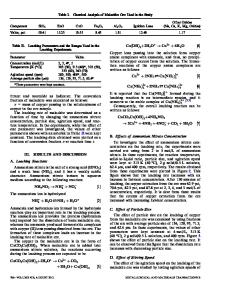Kinetic study of nonoxidative leaching of cinnabar ore in aqueous hydrochloric acid-potassium iodide solutions
- PDF / 685,769 Bytes
- 6 Pages / 603 x 783 pts Page_size
- 97 Downloads / 325 Views
I.
INTRODUCTION
CURRENT pyrometallurgical practice for the recovery of mercury has a number of disadvantages which are growing in importance: environmental pollution, high fuel consumption, generation of byproducts with high mercury content, and highly diluted sulfur dioxide emissions which make recovery a very difficult task. A hydrometallurgical process where metallic mercury and sulfur can be obtained in the elemental state may do away with these disadvantages. The leaching reactions proposed for cinnabar ore generally consist o f oxidation reactions o f sulfur in acid or basic media; however, when the reaction takes place in acid solution, it is poorly selective and dissolves iron and other elements that may also be contained in the ore. This makes it extremely difficult to recycle the leaching solution and demands treatment of the effluent before discharge to the environment. If oxidation occurs in a basic solution with hypochlorite, as several authors suggest, there is a progressive enrichment in sulfates which must be removed if the leaching solution is to be recycled. The process of nonoxidative leaching by acid and complexing attack o f cinnabar has antecedents based on its solubility in concentrated hydrobromic acid solutions. 1 In view o fthe ease of concentrating cinnabar by flotation, the cost of the leaching agent is not a major factor if it can be recycled and used again on further occasions. When the ore contains other metals such as compounds soluble in acid solution, these can be removed previously by washing with an inexpensive acid like H2SO4, thus preventing the introduction o f foreign ions into the operating circuit. The pyrite of Almaden's cinnabar ore (Spain) is not soluble in acid solutions when an oxidating reagent is not present. The reaction studied in this paper can be expressed as follows: HgS + 41- + 2H+ ~ Hgff + HzS
[1]
C. NUIqEZ is Professor of Extractive Metallurgy and Head of the Department of Metallurgy, Barcelona University. He is also head of the Emilio Jimeno Institute, Avenida Diagonal 645, Barcelona-28, Spain. F. ESPIELL is Assistant Professor in the Department of Metallurgy, Barcelona University, Barcelona, Spain. Manuscript submittedJanuary 10, 1983. METALLURGICAL
TRANSACTIONS B
This reaction takes place with high rate at room temperature when the HC1 and KI concentrations in the leaching solution are, respectively, 3 M and 0.5 M or greater. The hydrobromic acid requires higher concentrations. The elimination of the H2S generated in the leaching reaction by means of an air flow makes it possible to shift the equilibrium completely to the right. Therefore, a new process of cinnabar treatment for obtaining mercury can be proposed, consisting of the following two stages: The solution obtained in [1] is treated electrolytically: Hgff --* Hg + I~- + I-
[2]
In the regeneration of the attack solution, the iodine solution reacts with the gases resulting from the leaching reaction in o r d e r to regenerate the acid and produce elemental sulfur: 13 + H 2 S ~ S + 2H ÷ + 3I-
Data Loading...











